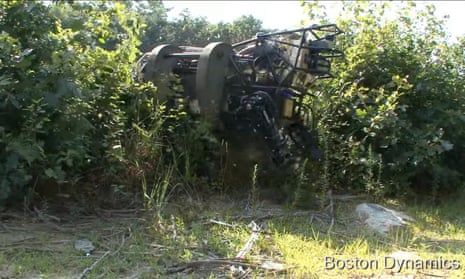The US military is cooling its eagerness for robots in the battlefield, after trials with quadrupedal robot and nightmare machine Big Dog revealed one crucial flaw: it’s much, much too loud.
The Big Dog robots, first demonstrated almost a decade ago, are developed by Boston Dynamics, a Massachusetts-based robotics firm that was purchased by Google in 2013. They became well known through a series of impressive demonstration videos showing the machine keeping its pace over uneven and slippery surfaces, and even managing to stay upright after a strong unexpected kick from the side.
But the robots, which have always been intended for military use (primarily as a futuristic beast of burden), have reportedly been ill-received by the US marine corps, which was testing out one version of Boston Dynamics’ quadruped: the Legged Squad Support System, or LS3.
Kyle Olson, a spokesman for the US marine corps’ Warfighting Lab, explained the problem to Military.com: “As marines were using it, there was the challenge of seeing the potential possibility because of the limitations of the robot itself. They took it as it was: a loud robot that’s going to give away their position.”
The loud whine of the larger packhorses that Boston Dynamics produces has become recognisable to followers of the company’s machines, but apparently it doesn’t please the soldiers who are expected to fight alongside them. A smaller, quieter version of the hardware named “Spot”, which runs on electric power rather than a petrol engine, solves that problem, but can’t carry anywhere near as much as the LS3. Both Spot and LS3 are reportedly in storage, with no future experiments planned.
When Google purchased Boston Dynamics in 2013, it committed to honouring existing military contracts, including one from the US defence research agency, Darpa, worth $10.8m. But it indicated that it intended to phase out the company’s reliance on the military for funding, instead focusing on manufacturing and industry automation.

Comments (…)
Sign in or create your Guardian account to join the discussion